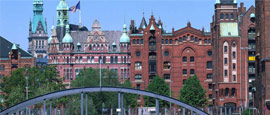The brand new Philharmonic Hall, which opened in January 2017 in the Speicherstadt area, is a lot more than just a concert venue. The modern building incorporates an historic warehouse complex, and offers a panoramic viewing platform, dining and general cultural experiences, along with a built-in hotel.
Things to see in Hamburg
Tourist offices
Address: Hauptbahnhof, Hamburg, 20355, Germany
Tel: +49 40 3005 1701.
Opening Hours:
Mon-Sat 0900-1900, Sun 1000-1800.
www.hamburg-travel.comHamburg’s main tourist information office is at the back of the Hauptbahnhof (main railway station), by the Kirchenallee entrance. There are also offices at the St Pauli Landungsbrücken (between piers 4 and 5) and in the airport at the new Airport Plaza (between Terminals 1 and 2).
One of the best ways to get into and around Hamburg and its main attractions is with the Hamburg Card, which can be purchased at the tourist office and gives unlimited travel on all public transport in the Greater Hamburg area as well as free or reduced-price admission to many top attractions, museums and excursions.
Europe’s second largest port and harbour district is a busy commercial area that’s still the beating heart of the city’s affluence and economic success, and parts (notably the Speicherstadt and Kontorhaus warehouse districts) have recently gained UNESCO World Heritage status. An early morning visit to the Fish Market is also a highlight. Don't miss the Hamburg Port Anniversary which is celebrated in May every year.
Put the city in context with a visit to the fascinating Museum of Hamburg History, and follow the story of this crucial harbour town, from it origins as an early settlement to its height as a Hanseatic port, trading from the 8th century right up to the present day. Detailed scale models of Hamburg at various times during its development will also help with orientation for further exploring. Conveniently located in the city centre, but closed on Mondays.
From humble origins, Hamburg’s church developed, from 1647 onwards, into the grand edifice that today forms such a prominent city centre landmark. With its unmistakable, 132m-high (433ft) baroque tower stunningly clad in beaten copper, ‘Michel’ continues to form an unmistakable part of the city skyline, even though it has undergone major reconstruction three times in its history, most recently after WWII.
The St Pauli district of Hamburg used to make rope for ships but you can bet anyone still doing that here today is using it for far more ‘specialist’ reasons. This is the area containing the Reeperbahn, a half-mile strip that’s become one of the most notorious red-light districts outside Amsterdam, and one which has similarly managed to attain acceptable tourist attraction status, as curious visitors mingle with the locals and the workers here in this vibrant melange of strip-clubs, bars, erotic theatres and glass-fronted bordellos.
Close to St. Michaelis Church, the curious can gain an insight into Hamburg life during the mid 19th century at the restored Grocers’ Institute houses, one of which has been preserved in its original condition with period furnishings. The buildings started life as housing for the widows of local shopkeepers.
As one of Germany’s most important art museums, Hamburg’s Kunsthalle houses a wealth of work from leading German artists, including the country’s masterful yet overlooked impressionists. There’s also plenty of space devoted to two of 19th-century romanticism’s most important painters, Caspar David Friedrich and Philip Otto Runge.
Claimed as the world’s biggest model railway, this is a draw for adults and children alike. More than 900 model trains trundle through miniature landscapes ranging from Scandinavia to Germany, Austria and even Las Vegas, along 15km (9 miles) of trackwork. It’s constantly growing as well, the latest highlight being a scale rendition of Hamburg’s newly opened Elbe Philharmonic Hall.
In a bustling metropolis that’s currently home to nearly 1.8 million people, this beautiful park right in the centre of Hamburg provides a green and leafy sanctuary for visitors and residents alike. This oasis of calm also houses Hamburg’s botanical garden. It also offers restaurants and cafés.
It may seem a slightly dated concept these days, but Hamburg’s zoo is still well worth a visit. It’s widely regarded, since being founded in 1907, as the zoo that set the gold standard for others around the world. Hamburg’s zoo was one of the first to do away with cramped, fenced enclosures in favour of large, open paddocks. Highlights include The Eismeer, where you can watch Arctic animals, and the Tropen-Aquarium.
Do you have any Feedback about this page?
© 2025 Columbus Travel Media Ltd. All rights reserved. No part of this site may be reproduced without our written permission, click here for information on Columbus Content Solutions.








 You know where
You know where